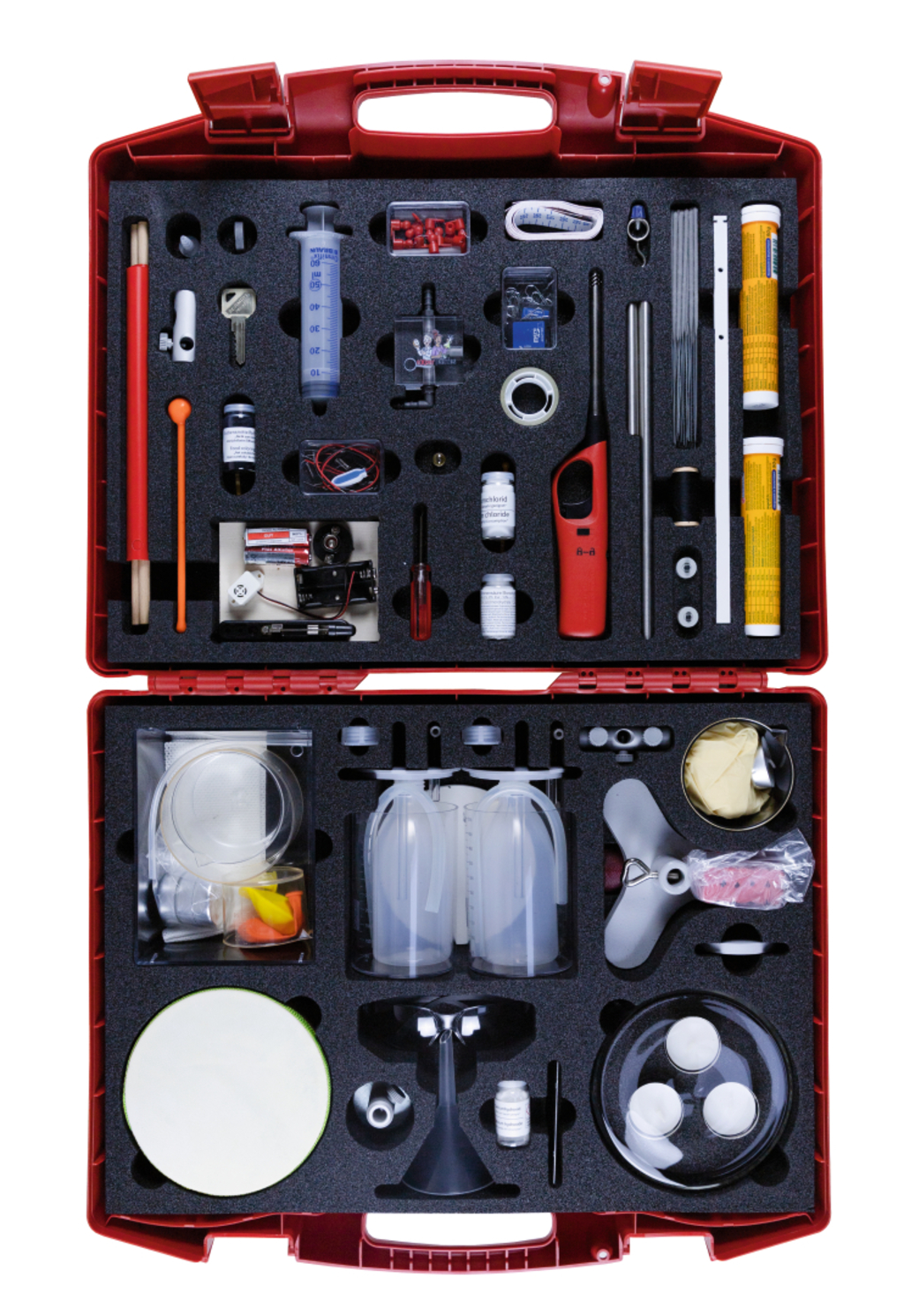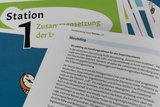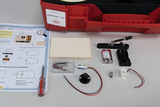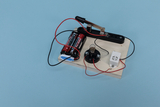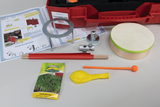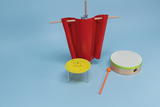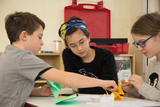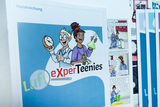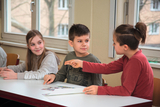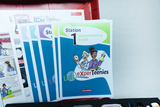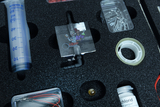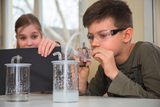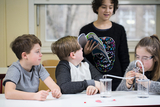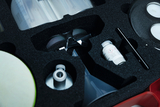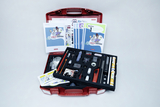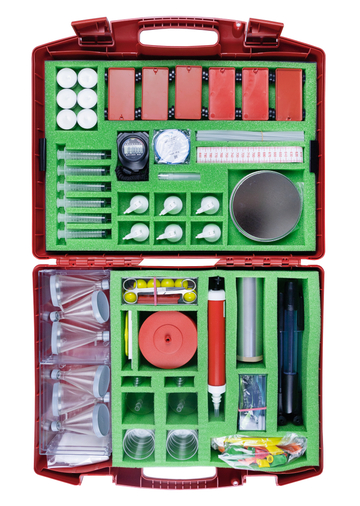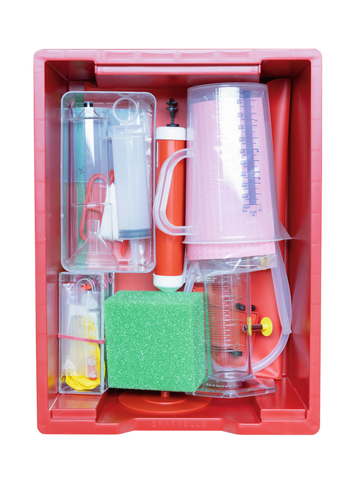Teaching material for experiments on air
eXperTeenies - Experiment set for your MINT lessons
Comics tell stories. The storytelling approach highly excite students since natural science topics get a personal meaning. The experience of every day life phenomena is the aim of our new experiment kit. Each experiment approach is accompanied by a short comic story with the main characters Cory & Nelson. The first kit includes more than 15 experiments linked to the topic “Air”.
Experiments at stations do not lead into a defined direction:
there is no right or wrong.
Each learner receives the support she or he needs.
The students are designated as expert for a certain station. This way they are in charge of his or her scientist team.
The “station expert” supports his / her team while realizing the experiment: either with posed questions, selection of material, the construction of the experiment or safety precaution.
The expert alternates at the next station.
This way everyone can participate in experimenting, find out correlations that lead to the answer of individual questions.
While experimenting the teacher is relieved through the expert and each student is individually supported.
The self-confidence and sense of responsibility is strengthenend due to the exchange of the expert function.
While teaching natural science the exchange between the student also enforces teamwork and sense for language.
Age 11-14
Materials for 1 work group or demonstration
Using a breathing regulator, the students test the introduction of oxygen and carbon dioxide into the detection solutions in two separate setups. In addition to the development of competence in measuring and the safe handling of chemicals, the test setups are designed in such a way that the detection reactions themselves can be dealt with intensively. Because it is important to find out which of the three available substances is suitable for detecting carbon dioxide.
The students have the task of ensuring safe transport for a memory card using a missile. They have materials at their disposal that should be used in a suitable way. During construction and testing, they learn about fundamental (technical and bionic) relationships between the paper surface used and the speed of fall, as well as the influence of weight and the flight of stabilizing and braking elements.
The students find out how a liquid-covered key can be dried out in a tub using air pressure. With the help of tea lights, the surrounding air is first heated and expanded. Putting a cup over the tealights makes them go out and the air cools down again. The liquid initially in the tub is pressed into the cup when the air pressure equalizes, so that the candles are lifted like in an elevator.
The students have to retrieve an object from a liquid-filled tub. A balloon and pump (syringe) are available for this purpose. You will learn how the pressure exerted by compressed air can be transmitted as a force and mechanical work can be performed in the process.
In the course of various partial constructions, the students examine the generation, propagation and transmission of sound. The aim is to set the grains on a membrane in motion with the help of a tambourine. Principles of soundproofing also come into play.
In an experimental setup with a buzzer that can be activated at the same time as a lamp, the aim is to find out which signal arrives at the receiver the fastest. Measurement methods and limitations are also examined.
The switching elements are to be arranged on a wooden board and interconnected in such a way that a lamp is activated at the same time as a buzzer. The students deal intensively with the arrangements of series and parallel circuits and apply them sensibly.
In the course of safely dealing with the fire triangle, the students research the requirements for the burning process and various extinguishing options. A candle staircase is also used, which behaves differently when oxygen is removed than when carbon dioxide is added.
The students set up a controlled chain reaction, at the end of which a tea light should be mechanically extinguished. The safe handling of fire (tea light and sparkler) is promoted as well as the structured and planned development of a reaction system.
A disc magnet is used to get a key out of a tub filled with liquid. The students learn about the principle of magnetic interaction and can try out ferromagnetism.
- 1 ×
- 1 ×
- 1 ×
- 1 ×
- 1 × Evaporating pan 140mmØ
- 1 × Colouring agent blue, E 132 in glass
- 1 ×
- 1 × Swing rod white with hole and notches
- 1 ×
- 1 ×
- 1 ×
- 1 × Acrylic glass regulator
- 1 × Plastic disc tea light holder
- 1 × Tealight holders 3 lengths
- 1 × Gas lighter
- 2 ×
- 2 × Effervescent tablets (container with 20 pieces)
- 2 × SD card adapter
- 1 × Key
- 1 × Curtain with 4 holes, red
- 2 ×
- 1 × Tambourine 150 mm ø
- 2 × Sparkler, 10 sticks
- 1 × Gloves, latex 100 pcs.
- 1 × Funnel, PP, 75 mmØ
- 1 × Wooden board, 120x90 mm
- 1 × Disc magnet, 30 mm Ø
- 1 ×
- 1 × Magnetic chuck with bosshead
- 1 × Tape measure 1 m, 10 pcs.
- 1 × Silicone tubing, 3/1 mm, per m
- 1 ×
- 1 × Safety goggles, small design
- 1 × Bosshead, triple
- 2 × Beaker, plastic 250 ml, graduated
- 1 × Filter paper, circular 125 mmØ, 100 pcs.
- 10 ×
- 1 ×
- 1 × Heat resistant pad, 50x50 cm
- 1 × Beaker, plastic 125 ml, graduated
- 1 × Flexible hearing tubing 630 mm
- 1 × Syringe plastic, 50 ml
- 1 × Plastic pot (old No.:90413)
- 1 × Bulb holder MES
- 3 × Plastic box, clear, 60/40
- 1 × Sewing thread, 100 m
- 1 × Silicone tubing, 6/1,5 mmper m
- 2 × Beaker, plastic 500 ml
- 1 × Battery holder, 2xR 6 cells without clip
- 10 ×
- 2 × Flask, PE, narrow neck 250 ml
- 1 × Stand rod 250x10 mmØ stainless steel
- 1 × °Glass with common salt (sodium chloride)
- 1 × Bulb 2,5 V / 0,2 A (10 pcs.)
- 1 × Bosshead, double
- 1 × Trough, plastic 173 x 132 x 70 mm
- 1 × Screw driver 110 mm
- 1 × Paper clips (100 pcs.)
- 1 × Tripod stand, 80 mm
- 1 × Plastic case ca.540x450x150 mm
- 1 ×
- 1 × Stand rod 100x10 mmØ stainless steel
- 1 × Knife switch, single polesingle throw
- 1 × Tripod stand
- 1 × Plastic mallet, 160 mm (drum stick)
- 1 × Set of 4 Mignon cells, alkaline, 1,5 V
- 10 ×
- 7 ×
- 3 ×
- 3 ×
- 1 × °Glass with citric acid
- 1 × Rubber balloons, 100 pcs.
- 2 × Lid plastic cup
- 1 × Aluminium mirror with 2 holes 90x90
- 1 × Rings with hook, set of 5
